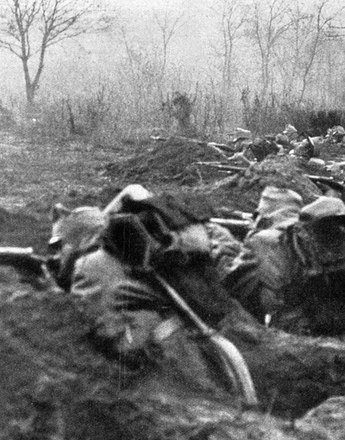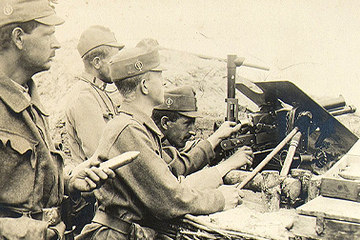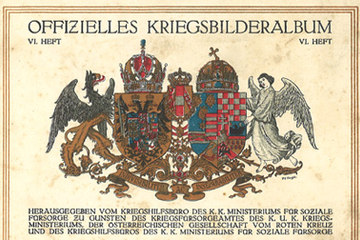The canon of images of the First World War as reflected in the illustrated press
-
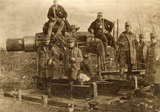
Group photo with artillery, Leopold Wolf war photo album, 1915
Copyright: Sammlung Frauennachlässe, Institut für Geschichte der Universität Wien/Fotografie: Angelika Spangel
Partner: Sammlung Frauennachlässe, Institut für Geschichte der Universität Wien -
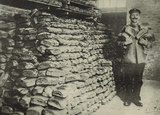
Stocks of bread at an army bakery, photo 1914/15
Copyright: Josef Neubauer
-
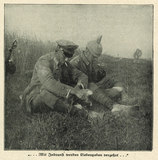
“... With ardour the gifts of love are eaten up ...”, photo 1914/15
Copyright: Josef Neubauer
-
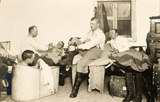
“Billets in Zalosce”, Leopold Wolf war photo album, 1915
Copyright: Sammlung Frauennachlässe, Institut für Geschichte der Universität Wien/Fotografie: Angelika Spangel
Partner: Sammlung Frauennachlässe, Institut für Geschichte der Universität Wien -
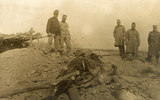
“Dead Russian”, Leopold Wolf war photo album, 1915
Copyright: Sammlung Frauennachlässe, Institut für Geschichte der Universität Wien/Fotografie: Angelika Spangel
Partner: Sammlung Frauennachlässe, Institut für Geschichte der Universität Wien -
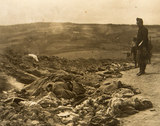
“Dead”, Leopold Wolf war photo album, 1915
Copyright: Sammlung Frauennachlässe, Institut für Geschichte der Universität Wien/Fotografie: Angelika Spangel
Partner: Sammlung Frauennachlässe, Institut für Geschichte der Universität Wien
The illustrated press had a decisive influence on the imagery of the war. It provided a social context in which the photographic image became a medium for social communication. However, the visual representation pattern of the war in the press was also subject to military control and censorship.
The pictorial canon of the First World War is characterised by photographs at the front. While the first images of the war showed soldier portraits taken far from the battlefields, the demand was soon heard for more spectacular photographs from the front. In particular when military successes were recorded, there was an increase in the demand for effective dramatic pictorial material. Newspapers hoped for spectacular images of the war and the illustrated press fought for the best pictures. The particular value of photography for newspapers and magazines lay in the authenticity that the public attributed to it. The viewer became an eyewitness of an apparent reality without actually being present.
At the demand of the media, pictures of the war zones and the front lines, of battle action and destruction became the dominant imagery of the war. Dynamic reporting, characterised by spectacular battle scenes, vivid close-ups and dramatic pictorial narratives began to dominate. Photographs of this kind were extremely rare but were so frequently reproduced that they became decisive for the pictorial history of the First World War, of which they were not representative.
What played a secondary role was the fact that the First World War was by no means conducted on clearly delineated battlefields. The camera only recorded the fate of the civil population on the margin. It was only in the second half of the war that the hinterland attracted the attention of the illustrated newspapers, the frontlines of the trench war having become rigid and reports from the front having ceased to be exciting. Nevertheless, the focus continued to be on the everyday life of the soldiers – the images showed the supplies and the provision of food in field camps, dental treatment, field bakeries, communal washing days and the like. The focus of these images was on the comradeship of the soldiers, and the war was presented as a tourist adventure. The aim of the published photos was to sustain an optimistic patriotic mood. Photographs of modern weapon technology, huge piles of equipment and modern war materials demonstrated the destructive force and fuelled the enthusiasm for industrialised war technology. These images were intended to communicate the certainty of victory and an aesthetic image of the war.
In contrast, shocking images were as a rule avoided. The characteristic taboo topic of published images was death in war, which was only indirectly a topic, such as through the publication of portraits of fallen soldiers or in the form of dead enemy soldiers. The dead body of the enemy demonstrated the military dominance of one's own country and became a trophy of the war efforts. In the official pictorial language of the war, death in one's own ranks was only shown abstractly and in the ritual of remembrance. Thus a pictorial canon was created in the media that only marginally corresponded to the real experiences of the soldiers and was characterised by a taboo on the reality of war.
Translation: David Wright
Holzer, Anton: Die andere Front. Fotografie und Propaganda im Ersten Weltkrieg, Darmstadt 2007
Holzer, Anton (Hrsg.): Mit der Kamera bewaffnet. Krieg und Fotografie, Marburg 2003
Holzer, Anton: Das Lächeln der Henker. Der unbekannte Krieg gegen die Zivilbevölkerung 1914-1918, Darmstadt 2008
Holzer, Anton: Der illustrierte Krieg. Fotografie und Bildberichterstattung 1914-1918, in: Alfred Pfoser/Andreas Weigl (Hrsg.): Im Epizentrum des Zusammenbruchs. Wien im Ersten Weltkrieg. Wien 2013, 486-493
Hüppauf, Bernd: Fotografie im Ersten Weltkrieg, in: Spilker, Rolf/Ulrich, Bernd (Hrsg.): Der Tod als Maschinist. Der industrialisierte Krieg 1914–1918. Eine Ausstellung des Museums Industriekultur Osnabrücl im Rahmen des Jubiläums „350 Jahre Westfälischer Friede“ 17.Mai–23.August 1998, Osnabrück 1998, 108-123
Paul, Gerhard: Bilder des Krieges – Krieg der Bilder. Die Visualisierung des modernen Krieges, München 2004
-
Chapters
- Public relations in the First World War: the state organisation for war reporting
- The WPH Photograph Office
- "Embedded photography": war photographers as part of military logistics
- Photography as a weapon: reconnaissance, surveying, documentation
- Who photographed the war? Snapshooters, amateurs, front tourists
- The canon of images of the First World War as reflected in the illustrated press
- The photographer as documentarian: the amateur's eye
- World War photography between traditional pictorial conventions and the Modern






